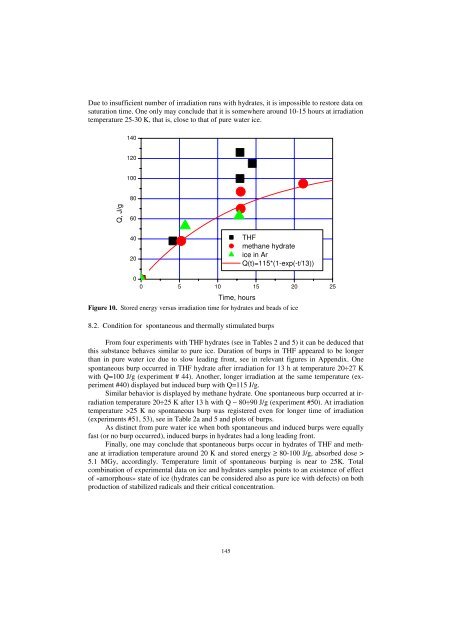Druck-Materie 20b.qxd - JUWEL - Forschungszentrum Jülich
Druck-Materie 20b.qxd - JUWEL - Forschungszentrum Jülich
Druck-Materie 20b.qxd - JUWEL - Forschungszentrum Jülich
Create successful ePaper yourself
Turn your PDF publications into a flip-book with our unique Google optimized e-Paper software.
Due to insufficient number of irradiation runs with hydrates, it is impossible to restore data on<br />
saturation time. One only may conclude that it is somewhere around 10-15 hours at irradiation<br />
temperature 25-30 K, that is, close to that of pure water ice.<br />
Q, J/g<br />
140<br />
120<br />
100<br />
80<br />
60<br />
40<br />
20<br />
0<br />
0 5 10 15 20 25<br />
Time, hours<br />
145<br />
THF<br />
methane hydrate<br />
ice in Ar<br />
Q(t)=115*(1-exp(-t/13))<br />
Figure 10. Stored energy versus irradiation time for hydrates and beads of ice<br />
8.2. Condition for spontaneous and thermally stimulated burps<br />
From four experiments with THF hydrates (see in Tables 2 and 5) it can be deduced that<br />
this substance behaves similar to pure ice. Duration of burps in THF appeared to be longer<br />
than in pure water ice due to slow leading front, see in relevant figures in Appendix. One<br />
spontaneous burp occurred in THF hydrate after irradiation for 13 h at temperature 20÷27 K<br />
with Q=100 J/g (experiment # 44). Another, longer irradiation at the same temperature (experiment<br />
#40) displayed but induced burp with Q=115 J/g.<br />
Similar behavior is displayed by methane hydrate. One spontaneous burp occurred at irradiation<br />
temperature 20÷25 K after 13 h with Q ∼ 80÷90 J/g (experiment #50). At irradiation<br />
temperature >25 K no spontaneous burp was registered even for longer time of irradiation<br />
(experiments #51, 53), see in Table 2a and 5 and plots of burps.<br />
As distinct from pure water ice when both spontaneous and induced burps were equally<br />
fast (or no burp occurred), induced burps in hydrates had a long leading front.<br />
Finally, one may conclude that spontaneous burps occur in hydrates of THF and methane<br />
at irradiation temperature around 20 K and stored energy ≥ 80-100 J/g, absorbed dose ><br />
5.1 MGy, accordingly. Temperature limit of spontaneous burping is near to 25K. Total<br />
combination of experimental data on ice and hydrates samples points to an existence of effect<br />
of «amorphous» state of ice (hydrates can be considered also as pure ice with defects) on both<br />
production of stabilized radicals and their critical concentration.

















